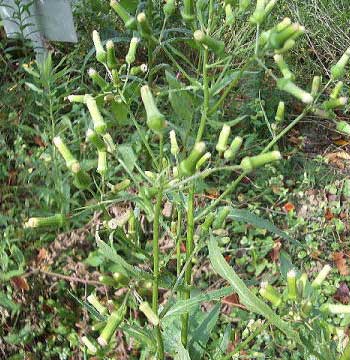Contents:
Common Names | Parts Usually Used | Plant(s) & Culture | Where Found | Medicinal Properties
Legends, Myths and Stories | Uses | Formulas or Dosages | How Sold | Warning | Bibliography
Scientific Names

- Erechthites hieracifolia L.
- Compositae
- Composite family
Common Names
- Fireweed
- Various leaved fleabane
Parts Usually Used
Whole plant
Back to Top
Description of Plant(s) and Culture
Pilewort is a native North American annual plant; the thick, succulent, grooved stem grows from 1-8 feet high and bears alternate, lanceolate, acute irregularly dentate leaves, 2-8 inches long, that are petioled near the bottom of the plant and clasping near the top. Whitish, brush-shaped flower heads grow in loose terminal clusters from July to October. The plant has a disagreeable odor and taste. The fruit, an achenium, is oblong and hairy.
Somewhat resembles Sow thistle.
Also called fireweed (E. angustifolium L.) of the Evening-primrose family. Native Americans poulticed peeled root for burns, skin sores, swelling, boils.
Back to Top
Where Found
Grows in fields, woods, waste places, and burned-over areas from the Atlantic coast westward to Saskatchewan, Nebraska, Texas, and Mexico.
Back to Top
Medicinal Properties
Alterative, astringent, cathartic, emetic, tonic
Back to Top
Legends, Myths and Stories
Another plant is known as pilewort (Ranunculus ficaria), used to treat piles, constipation, and varicose veins. If taken internally, do not use without medical supervision.
Back to Top
Uses
Pilewort can be used for diarrhea cystitis, dropsy, colon trouble, tonsillitis, hay fever, dysentery, cholera, blood purifier, and for fever. Said to be very effective against hemorrhoids. In large doses it produces vomiting.
Externally, used for muscular rheumatism, sciatica.
The tincture of the fresh whole plant is used for diarrhea, gonorrhea, hemorrhage, metrorrhagia, and orchitis (inflammation of the testes).
Back to Top
Formulas or Dosages
Infusion: steep 1 heaping tsp. of the plant in 1 cup boiling water for 30 minutes. When cool, take 1 to 2 cups a day, one swallow at a time.
Tincture: take 1/2 to 1 tsp. at a time.
Back to Top
How Sold
Capsules
Back to Top
Warning
In large doses it produces vomiting. Take only for one week at a time.
Take the capsules with a swallow of milk.
Back to Top
Bibliography
![]() American Folk Medicine
American Folk Medicine, by Clarence Meyer, Meyerbooks, publisher, PO Box 427, Glenwood, Illinois 60425, 1973
![]() Back to Eden
Back to Eden, by Jethro Kloss; Back to Eden Publishing Co., Loma Linda, CA 92354, Original copyright 1939, revised edition 1994
 How Indians Use Wild Plants for Food, Medicine & Crafts
How Indians Use Wild Plants for Food, Medicine & Crafts, by Frances Densmore, Dover Publications, Inc., 180 Varick Street, New York, NY 10014, first printed by the United States Government Printing Office, Washington, in 1928, this Dover edition 1974
![]() The Complete Medicinal Herbal
The Complete Medicinal Herbal, by Penelope Ody, Dorling Kindersley, Inc, 232 Madison Avenue, New York, NY 10016, First American Edition, copyright 1993
![]() Eastern/Central Medicinal Plants
Eastern/Central Medicinal Plants, by Steven Foster and James A. Duke., Houghton Mifflin Company, 215 Park Avenue South, New York, NY 10000
![]() The Herb Book
The Herb Book, by John Lust, Bantam Books, 666 Fifth Avenue, New York, NY. copyright 1974.
![]() Indian Herbalogy of North America
Indian Herbalogy of North America, by Alma R. Hutchens, Shambala Publications, Inc., Horticultural Hall, 300 Massachusetts Avenue, Boston, Massachusetts 02115, 1973
![]() Webster’s New World Dictionary
Webster’s New World Dictionary, Third College Edition, Victoria Neufeldt, Editor in Chief, New World Dictionaries: A Division of Simon & Schuster, Inc., 15 Columbus Circle, New York, NY 10023
